Best Knot for Tying Fly to Tippet
Knots for Fly-Fishing
Learning to tie good knots is one of the most important things you can do as a beginning fly angler to enhance your experience on the water and catch more fish. Not only will tying strong knots help you land the big ones, you will be able to set up your equipment and retie lost or tangled rigs faster while you are out on the water and spend more time fishing. This article will teach you how to tie the most effective and useful knots that you will use on the water while fly-fishing.
Fly Connections
A good fly connection is what attaches your fly to the end of your leader and keeps it there. It is by far the most important connection that you will tie when fly-fishing. With the right knot, you will put more fish in the net, save more flies from snags, and, in some cases, give your fly better movement in the water.
Clinch Knot
There are many different knots that will work for tying your fly to your tippet, and the clinch knot remains one of the best choices. The clinch is a proven knot that has gained worldwide popularity for being both strong and simple to tie.
A good knot should be easy enough to tie that you aren't struggling with it on the water while you should be fishing. With practice, it should be manageable with numb fingers on a cold day or when it is hard to see during low-light hours. The clinch is all of these things, along with being reliable. When tied with care, it has good breaking strength and will not slip even if the tag end is trimmed very close.
How to tie a clinch knot:
- Hold the hook in your left hand and pass the tippet through the eye of the hook; double the tag end back so it lies parallel to the standing line. Use your left forefinger to keep an open loop just in front of the hook eye and hold the standing line in your right hand.
- Use the thumb and forefinger of your right hand to wind the tag end around the standing line 4-5 times.
- Once the tag is twisted around the standing portion, remove your forefinger from the hook eye, taking care to keep an open loop. Pass the tag end of the tippet through the open loop in front of the hook eye.
- This is the most important part. Snug the knot by pulling gently on the tag end until the wraps come together, but do not tighten it all the way. Release the tag, wet the knot with saliva, and pull from the standing portion of the leader to allow the knot to fully tighten. Trim the tag close to the hook eye and get that fly in the water.
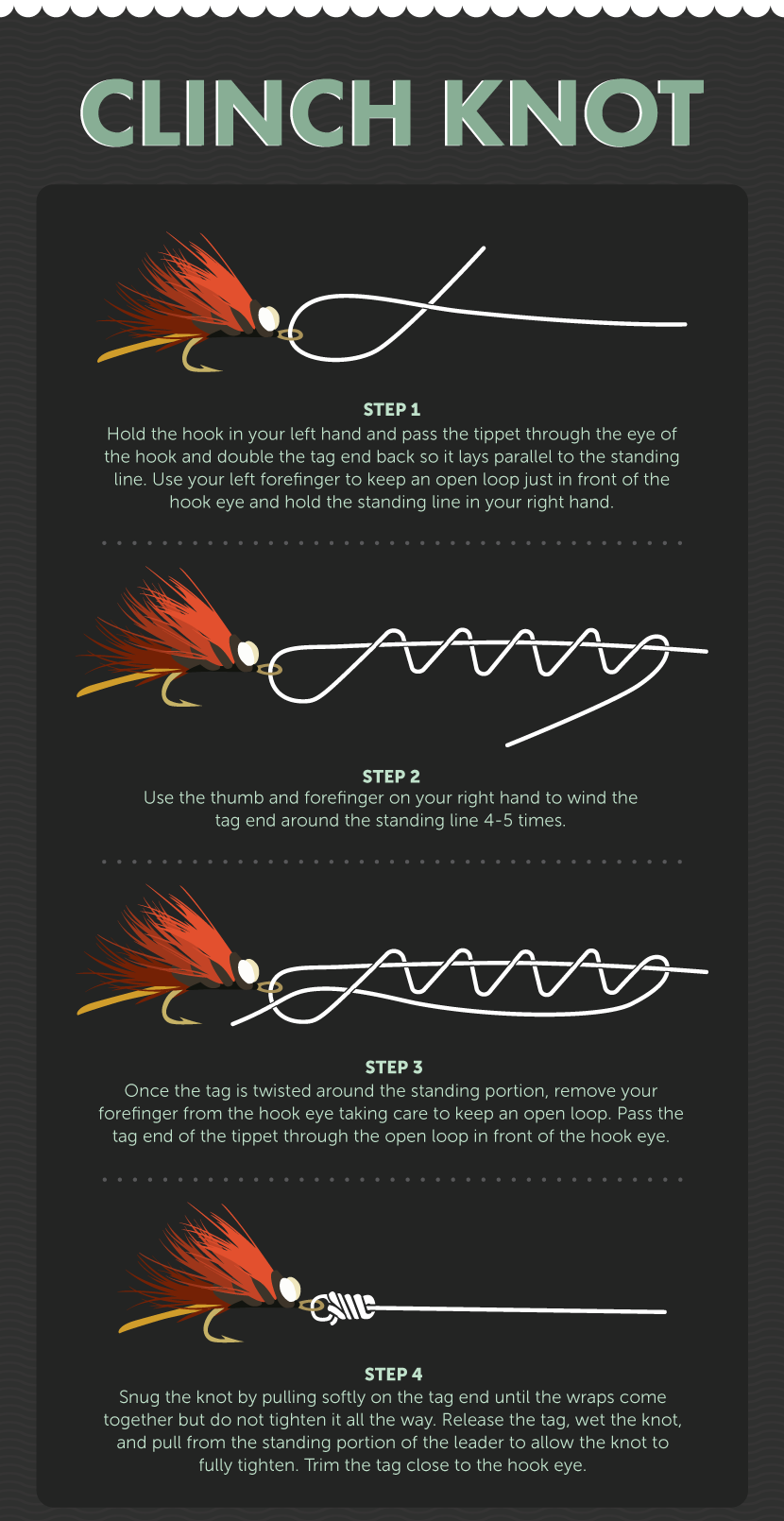
Nonslip Loop Knot
When fishing certain types of flies such as streamers, using a loop knot to connect your fly to the tippet will enhance the movement and action of the fly in the water. The nonslip loop is one of the strongest knots in this category and will never slide down or cinch tight on your fly like some other knots.
Choose a loop knot when you are fishing streamers, poppers, or other types of flies that are retrieved with a stripping technique. The open loop that connects the leader to the hook eye allows the fly to swing freely at the end of the tippet, which enhances its wobbling, darting, or otherwise erratic action in the water.
How to tie a nonslip loop knot:
- Make an overhand knot in the tippet a few inches from the end, but do not tighten it all the way.
- Pass the tag end of the tippet through the eye of the hook, then double it back and pass it through the overhand knot.
- Wrap the tag end around the standing line 4-5 times and then bring it back around and through the overhand knot, passing through the center of the knot.
- Wet the knot with saliva and pull slowly from the tag end to tighten the knot, then pull from the loop and standing ends to make sure the knot is seated. Trim the tag short and go fish.
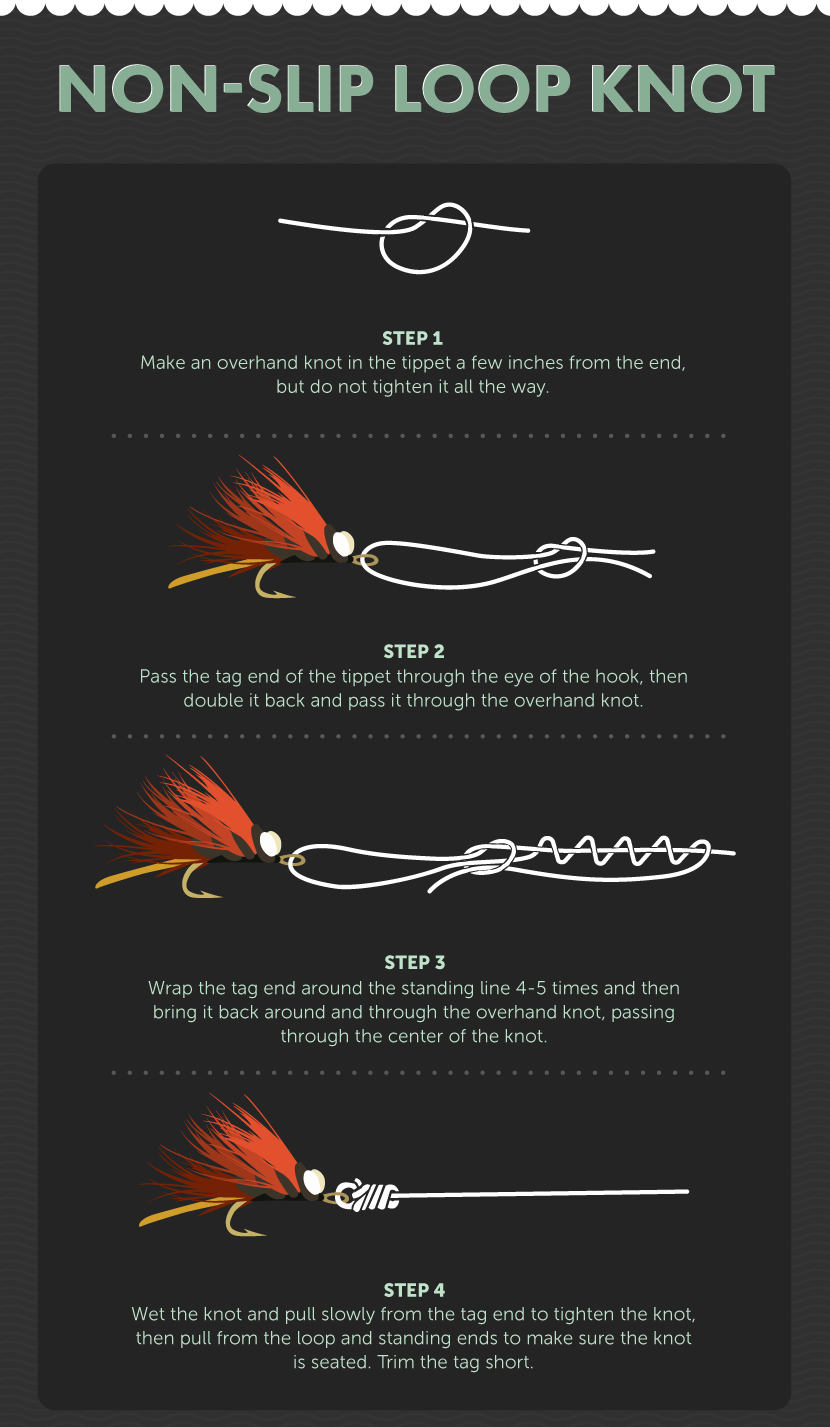
Leader Connections
A second essential skill you will need to learn is how to connect sections of leader and tippet material together while you are out on the water. There are multiple reasons you might need to tie two pieces of material together while fishing, from adding tippet to a leader to replacing lost material if you get a snag or break off on a big fish. Regardless of the reason, practicing these connections will ensure that you can tie them quickly and get your flies back in the water.
Double Surgeon's Knot
The double surgeon's knot may not be the prettiest knot for connecting two pieces of material, but it is certainly the simplest and most efficient connection you can use. When you first begin fly-fishing, it may sometimes seem like you spend as much time retying and untangling rigs as you do fishing! Learning leader connections that are fast and easy to tie minimizes time wasted and allows you to get your flies back in the water in a hurry. The double surgeon's knot is tough, reliable, and super fast to tie with some practice.
How to tie the double surgeon's knot:
- Hold the end of your leader in one hand and the tippet you are attaching in the other hand. In each hand you should have about 4-6 inches of free tag material to work with. Arrange the tags so they overlap, are lying alongside one another, and facing in opposite directions.
- Find the center of the overlap and form a big loop in the overlapping portion, pinching the junction where the loop crosses between your left thumb and forefinger.
- Using your right hand, wrap the tag end of the leader and the end of the tippet around the loop and pull it through. Repeat this step once more so that you have made a total of two wraps through the loop.
- Hold both the short and the long portion on both sides of the knot. Wet with saliva and tighten by pulling with both hands in opposite directions. Trim the two tag ends close to the knot.
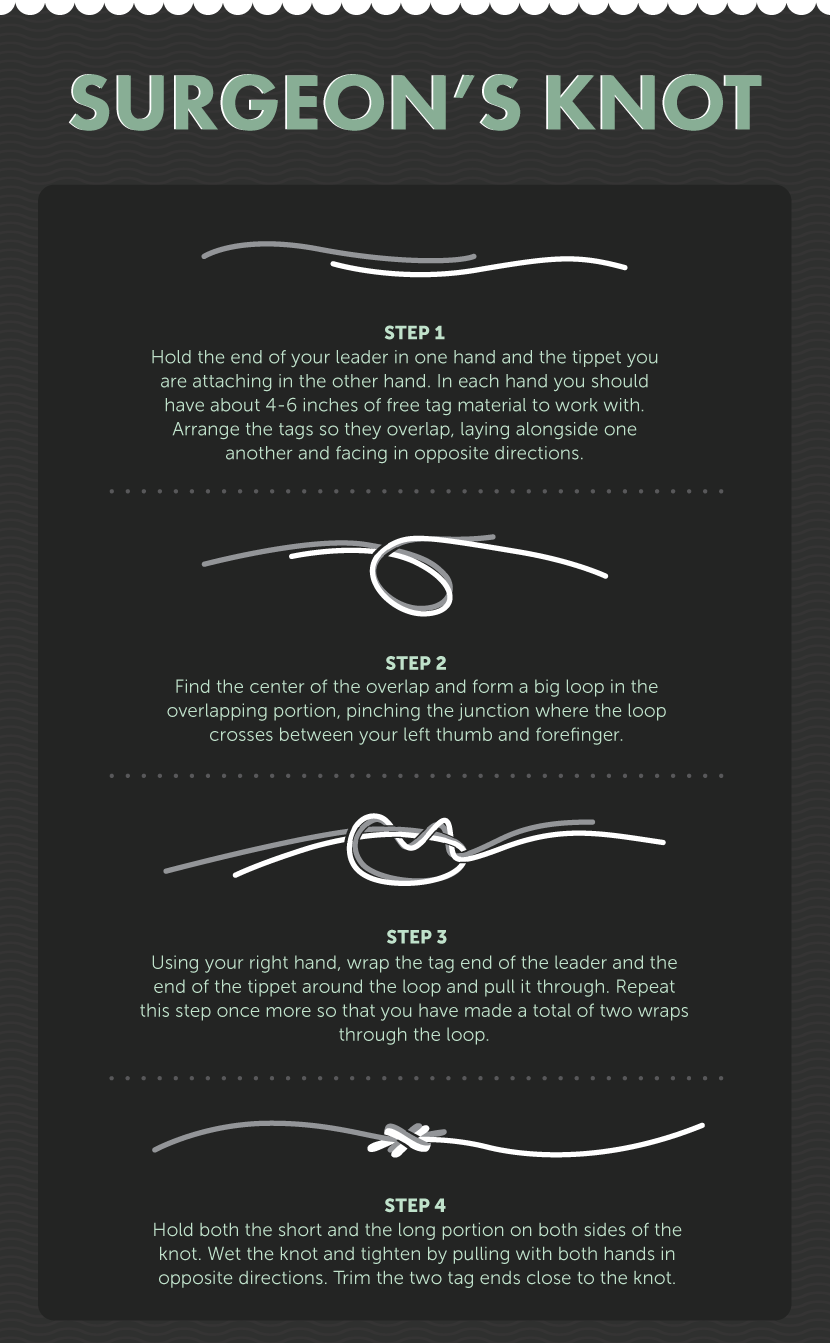
Loop-to-Loop Connection
Many fly lines and store-bought leaders now come with premade loops at the ends so you can quickly change them out when needed. Learning to connect your leader loop to your fly line correctly will save you time and frustration when you are out on the water. Here we will describe how to attach a new leader to a looped fly line using a loop-to-loop connection.
How to make a loop-to-loop connection:
- Hold the line loop in your left hand and the leader butt section with loop in your right hand.
- Pass the line loop through the loop in the butt section of the leader.
- Find the end of the leader and pass it through the line loop.
- Pull the loops in opposite directions to draw them together. When done correctly they should form a "handshake-style" interlocking connection that will flex and move naturally to transfer the energy of your cast smoothly from line to leader.
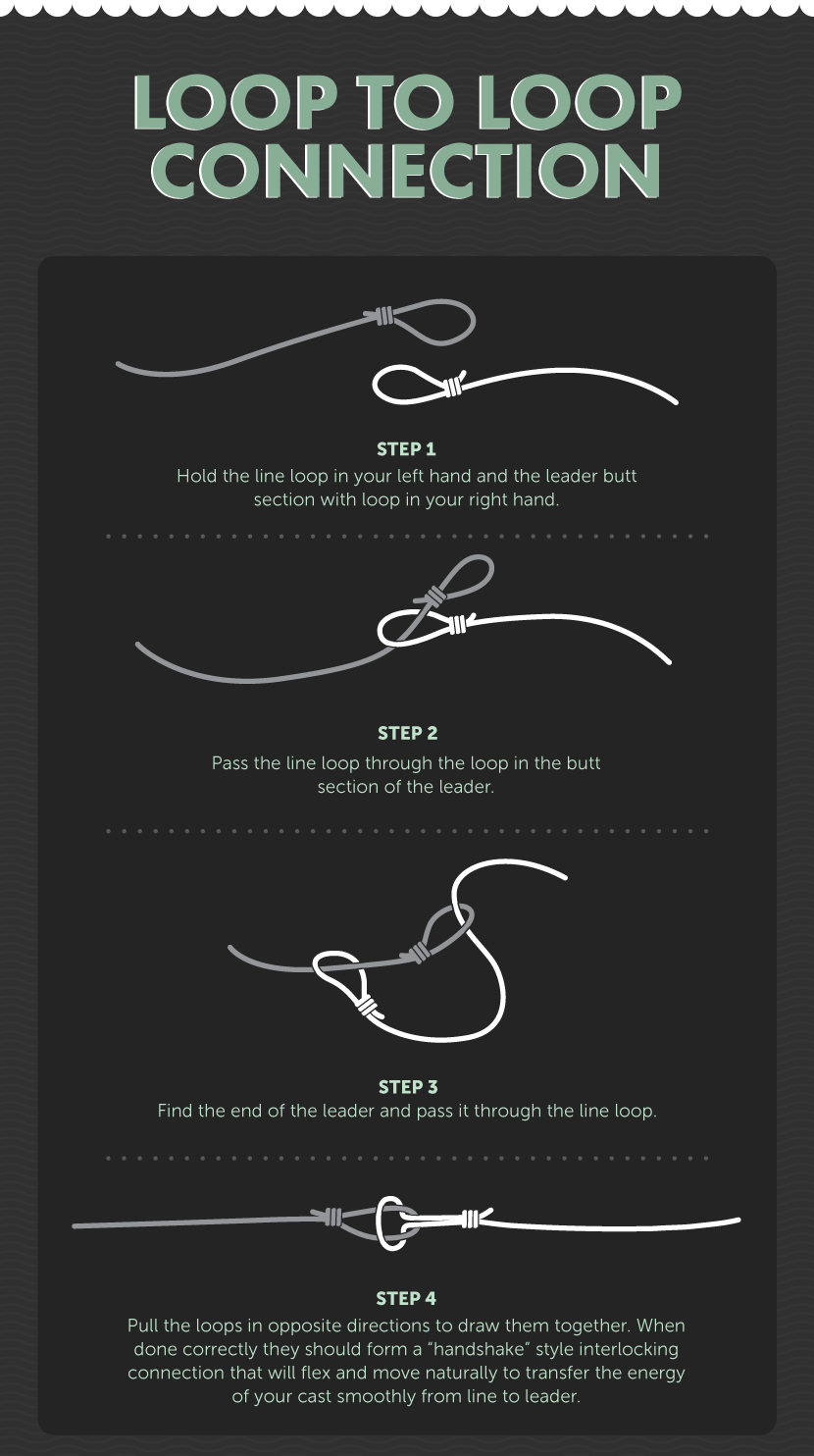
Albright Knot
While many people choose to use the loop-to-loop to join their leader to their fly line, some still prefer to attach the leader directly to the fly line. The Albright knot is one of the strongest direct leader-to-fly-line connections you can make. It is faster, easier to tie, and does not require special tools like some other line-to-leader connections. Learning this knot will also help if your loop-to-loop connection happens to break during fishing and you need to tie it back together.
How to tie the Albright knot:
- Hold the end of the fly line in your left hand and fold it over, forming a loop with about 6 inches of tag.
- Using your right hand, pass the butt of the leader through the loop and bring 8-10 inches of material through the loop. Pinch the tag end of the leader butt along with both "legs" of the line loop between your left thumb and forefinger.
- Double the leader butt back and use your right hand to wrap it over itself and the line loop 8-10 times, traveling toward the end of the loop you made in the line.
- Pass the tag end of the leader but through the loop, making sure it exits the loop on the same side that it originally entered.
- Wet the knot and slowly draw it tight by pulling from all four ends evenly. You may need to use your fingers to carefully "tease" the leader wraps into position and keep them from overlapping as the knot draws closed.
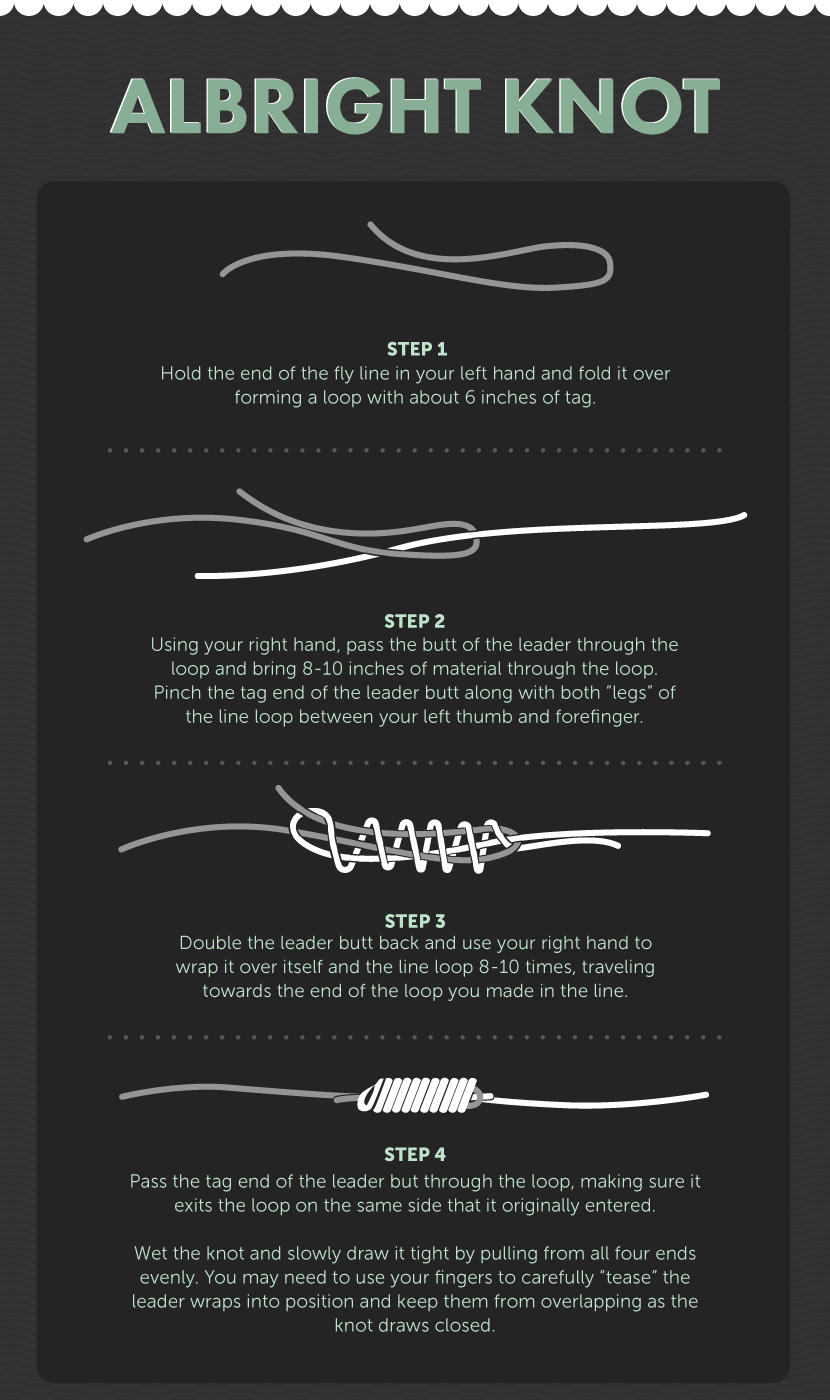
As with any fly-fishing technique, practicing these knots at home will help you get the hang of them and ensure that you are able to tie them quickly should the need arise on the water. I recommend beginning with something thick and bright like paracord or nylon rope, then graduating to the smaller-diameter material you will be using while fishing. Practice these knots and you are guaranteed to have a better experience out on the water every time.
Embed the article on your site

Best Knot for Tying Fly to Tippet
Source: https://www.fix.com/blog/learn-to-tie-fly-fishing-knots/
0 Response to "Best Knot for Tying Fly to Tippet"
Post a Comment